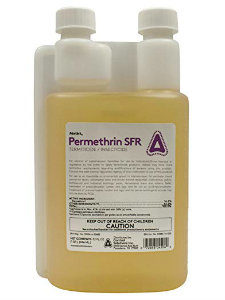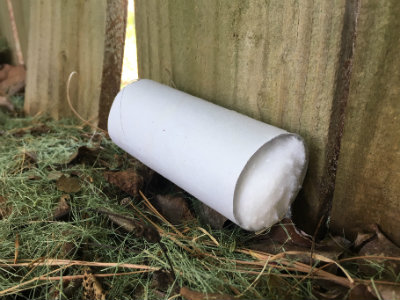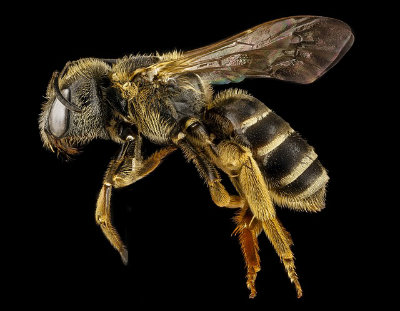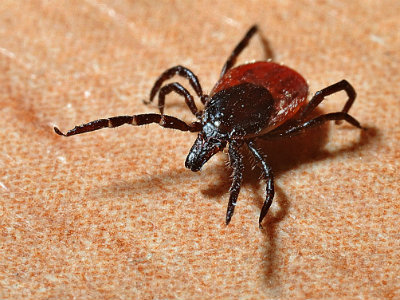Ticks are more than a nuisance bug. They are a vector that can transmit life-altering diseases. There are plenty of ways to protect yourself from ticks- but at some point, you need to be able to breathe easy in your own yard. That is where homemade tick tubes come into play.
You can buy ready-made tick tubes online, but they are ridiculously easy to make yourself and you probably have all of the ingredients already. A routine of checking yourself for ticks is the best way to prevent tick bites, but taking the fight to them with tick tubes is right up there with it.
Contents (Jump to a Section)
- What You Need to Make a Tick Tube
- How to Make a Tick Tube
- Where to Put Tick Tubes
- How Long do Homemade Tick Tubes Last?
- How Tick Tubes Work
- Are Tick Tubes Safe for Bees?
- Are Tick Tubes Safe for Humans?
- Natural Ways to Get Rid of Ticks
- What’s Wrong With Ticks?
What You
Need to Make a Tick Tube
Tick tubes are extremely easy to make and you only need a few
materials:
- Toilet paper tube (or paper towel tube)
- Dryer lint (or cotton balls)
- Permethrin
- Gloves
- Mask
If you are looking for a more permanent solution, a section of PVC pipe may be best. Toilet paper tubes are cheap, and if your family is anything like mine- you’ll have plenty of them in no time. Tick tubes are meant to be placed temporarily since ticks are seasonal- but we’ll get more into that later.
Dryer lint or cotton balls or anything that a rodent can carry and use in its nest is preferred. The point is that the rodent carries the material back to its home to use in its nest.
Next, we’ll need the active ingredient: Permethrin. Permethrin is the good stuff. Permethrin is a strong insect killer and is what the tick tube is all about. Its main use is for treating clothing and outdoor gear to repel insects. In the Air Force, it was an essential deployment item included in everyone’s rapid deployment bags.
Permethrin has many different concentrations that you can buy off the shelf. The ready-use spray bottle is the easiest and most convenient. Commercial-grade bottles should be diluted before use. Some states may not let you purchase the commercial grade.

Ready to use – fast and easy.

Must be diluted – cheaper for large applications.
How to
Make a Tick Tube
Since you have all the gear to make homemade tick tubes now, you are 90% done. Next, all you need to do is:
- Put on your mask and gloves
- Spray permethrin on the dryer lint (or cotton) and let it dry
- Lightly pack the dryer lint or cotton inside of the toilet paper tube
Now I told you that would be easy.

Homemade tick tubes are fast, easy, and cheap!
Permethrin has all sorts of warning labels on it, so protecting your face and your hands is a good idea. Most mixtures are safe for humans, dogs, wildlife, rodents, etc. when it is dry. When it is not yet dry, it does list that it is dangerous for cats to be exposed to so be careful when applying and letting permethrin dry. If you opted to get some concentrate, be sure to use the suggested mix ratio when you apply the permethrin. Thoroughly coat the dryer lint or cotton balls and allow them to dry before you stuff them into the tube.
Also, be aware of the wind conditions and flowering plants nearby when applying the permethrin. It is toxic to bees, but we talk more about that further below.
Once you have all of your tubes loaded, you are ready to
rock-n-roll and get rid of some ticks.
Where to Put Tick Tubes
Place yourself in a rodent’s tiny shoes. Where would you go if you were rounding up stuff for your nest?

Rodents don’t just carry disease themselves- their small passengers can also carry disease!
Well, first off you want to place the tubes around the perimeter
of your yard- especially if you have a fence. Most commercial brands will tell
you to deploy just the perimeter. If you make your own tubes, they are much
cheaper and you can afford to use more of them for better coverage.
Next, you need to look for runs around buildings, woodpiles,
overgrown areas, and rocky outcrops. Mice, squirrels, and other small mammals
love these areas- and ticks love them.
The spacing you want to keep for your tick tubes is one tube every 3-9 yards. The frequency depends
on how thorough you want to be, how many rodents are in your area, and how many
ticks are in your area.
How Long Do Homemade Tick Tubes Last?
Permethrin is waterproof so you don’t need to worry about it rinsing off the dryer lint or cotton balls. In most places, replacing the tick tubes or just the dryer lint and cotton balls is recommended twice a year, so tick tubes last about 6 months.
If you check the tubes and the fluff is gone (to a mouse nest, etc) then you will need to go ahead and swap it out.
April and July are great times of year to place a batch of tick tubes. This matches up with when the nymphs and the larvae are around.
Permethrin is waterproof so you don’t need to worry about it rinsing off the dryer lint or cotton balls. In most places, replacing the tick tubes or just the dryer lint and cotton balls is recommended twice a year.
How Tick
Tubes Work
When ticks are small, they still need to feed. Dropping onto a
large animal can be a daunting task for a tiny baby tick, so most go for the
easy food source: rodents.
40% of all mammals are rodents. They stay close to the ground, are
plentiful, and make for a nice meal for any newborn tick.
The convenient thing about most rodents is that they love making homes. By setting tick tubes out for them, they carry the permethrin-treated dryer lint back to their home to nest in. The permethrin kills the ticks and any other ticks that piggyback to the rodent’s home in the future.
Scientists have discovered that white-footed mice, short-tailed shrews, and eastern chipmunks are large contributors to larval ticks with Lyme bacterium. All of these are nesting rodents that make tick tubes effective.
This YouTube video does a very effective job of showing how tick tubes work (and more):
Are Tick
Tubes Safe for Bees?
Unfortunately, the active ingredient in tick tubes is toxic for bees. Bees are an important part of our ecological system, so it is best to keep the tick tubes away from flowers and flowering trees and shrubs. It is also best to keep them low, which makes sense since we are targeting mostly mice.

Bees are an important part of our ecological system, so be careful when applying permethrin or placing tick tubes.
When you are applying the permethrin to the cotton or lint, make sure you do it away from blooming trees, shrubs, and flowers. It is also best to apply when the wind is low or able to be blocked.
Place your tick tubes on the ground and away from bee flight paths. Tick tubes are most effective where the rodents can easily reach them, so you should not be placing them far off the ground anyways.
Are Homemade Tick Tubes Safe for Humans?
Permethrin is safe for anyone when it is applied properly. It is typically used to treat clothing. In the military, we would treat all of our uniforms with permethrin prior to deployment. Permethrin is less absorptive than DEET since only 1% of the active ingredient is absorbed with direct skin contact. DEET is about 20%.
Permethrin-treated clothing is 27 times below the EPA Level of Concern (LOC) when exposed to toddlers. The toxicity level is extremely low for humans although it is very high for ticks (2250 times more toxic to ticks).
Permethrin is widely regarded as a safe pesticide treatment for
clothing.
Natural
Ways to Get Rid of Ticks
If you are truly worried about the permethrin in tick tubes, you
can choose other methods to reduce the number of ticks in your area. Some of
the best non-chemical ways include:
- Open up the Canopy. Ticks thrive in shady moist areas and do not do well in sunny dry areas. Getting rid of the shade or moving living spaces like swing sets, forts, and sandboxes away from shady areas can reduce tick exposure.
- Clear out Debris. Leaves, grass clippings, and downed limbs all provide a place for ticks to hide. Keep lawn height down by mowing regularly so tall grass does not entice them either.
- Repel Deer. Fences, plants that don’t attract deer, and deer repellent can all help prevent deer and their hitchhikers from entering your yard.
- Check your Pets. Outdoor pets should be outfitted with tick collars and spray. You do not want them getting ticks or tick-related diseases, and you definitely don’t want them bringing ticks indoors.
Using the tips above AND permethrin-treated tick tubes is the best strategy to reduce ticks in your area drastically.
What’s
Wrong with Ticks?
In many parts of the world, if you have been into the woods you have probably encountered a tick. These small insects drop onto mammals, latch on, and fill up with blood. They are a parasite.

The plentiful parasite: the infamous tick
In order to keep the blood flow going and to prevent coagulation,
they inject some enzymes into the bite spot. Unfortunately for us, this can
transmit diseases such as:
- Lyme Disease
- Anaplasmosis
- Rocky Mountain Spotted Fever
- Bovine’s Revenge
Just to name a few…
The Center for Disease Control pleads for people to take caution with ticks. These diseases can be debilitating, life-altering, and difficult to detect and treat.
Ticks can also have a population explosion in the right
circumstances. With plenty of food and a perfect habitat, they can rapidly grow
in numbers. This can greatly increase your exposure to ticks and where both
tick tubes and personal protection are important.
The Final
Word
The irony of how tick tubes work is not lost on me. We use another disease vector, rodents, to carry pesticides to their own nests to eliminate ticks. Rodents have been a pretty big threat to human health throughout history, and it is nice that we can turn the tables by weaponizing rodents against ticks with homemade tick tubes. If rodents are your problem, you may want to check out:
- 10 Homemade Mouse and Rat Traps
- The Best Snare Wire Traps for Survival Trapping
- Home Survival Kit Guide, Gear, and Checklist
Keep exploring, stay prepared, and be safe.
You’ve Been Missing Out
Join the 2+ million preppers that rely on our prepping advice by subscribing to TruePrepper.
- Practical guides and tips
- Useful survival giveaways
- Free, forever
- < 0.4% of people unsubscribe
Thanks for subscribing, reading, and welcome to the club.
The post How to Make Homemade Tick Tubes appeared first on TruePrepper.
By: Rusty Collins
Title: How to Make Homemade Tick Tubes
Sourced From: www.trueprepper.com/homemade-tick-tubes/
Published Date: Mon, 20 Mar 2023 13:17:29 +0000
-------------------------------------------------------------------------
Did you miss our previous article...
https://outdoorsnewswire.com/survivalist/canine-cuisine-eating-dog-food-in-dire-situations
 CampingSurvivalistHuntingFishingExploringHikingPrivacy PolicyTerms And Conditions
CampingSurvivalistHuntingFishingExploringHikingPrivacy PolicyTerms And Conditions
